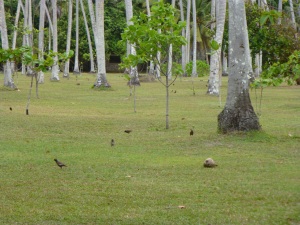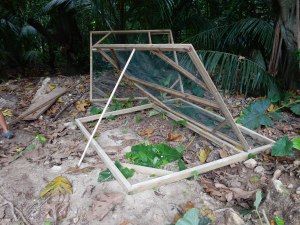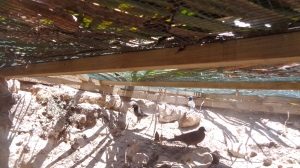In May 2016 Christine and I visited North Island, Seychelles, to begin another WildWings Bird Mangement-led attempt to eradicate Common Mynas from the island (see blog post of 21 May 2016). The project is being funded by both GEF/UNDP and North Island and managed by Green Islands Foundation, and is undertaken by volunteers that Christine and I have trained.

The current pair of volunteers, Jeremy Waters from UK and Maxine Little from Australia, have been working on the project since August and have experienced the inevitable ups and downs, successes and frustrations, of this kind of work. For reasons that we do not fully understand, catches of mynas have varied over time but recently successes have dominated. Jeremy and Maxine have continued using decoy traps throughout but went through a period during which the catch rate waned wherever they were located. Mynas had changed their behaviour, possibly due to drought, and ceased feeding on the extensive grassland on the eastern plateau that usually provides them with rich feeding areas. The birds continued feeding at a site on the western coast where organic waste is buried, but where we had earlier failed to catch birds in decoy traps. On moving most of the traps to this area Jeremy and Maxine had a sudden surge in catches and this was augmented by using a new drop trap, originally conceived by Christine and me and part-built by the island’s Maintanance Team, but during our short visit we were unable to put it into operation.

This is a large wooden framed drop trap, covered in netting, and placed over the pit in which organic waste is deposited daily. To extract caught birds a person has to enter the pit through a small trap-door in the net. Jeremy reports that this is a messy business, requiring protective clothing and a face mask – and a capacity to ignore the milling throngs of flies and maggots through which he has to crawl to reach the birds! Nonetheless, use of this trap has increased the rate of catching mynas, and in addition they are also being caught in decoy traps again.

With their dedication and ingenuity, it looks as though Jeremy and Max are progressing towards our goal of eradicating mynas from North Island. This will open up the island for the introduction of some of Seychelles’ rare endemic land birds, whose survival depends on moving them to islands that are free of rats and mynas, which have been responsible for the disappearance of endemic birds and preventing their recolonisation on islands where these predators have established a foothold. While the eradication of rodents, especially rats, from islands have now become commonplace with protocols based on knowledge and materials built up over many years as a result of public health concerns, eradication of invasive birds is a relatively new development and we have to learn as much as possible from each attempt in order to work out best practice protocols for these species.